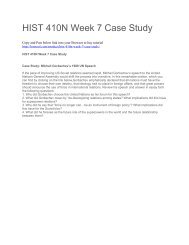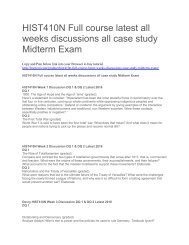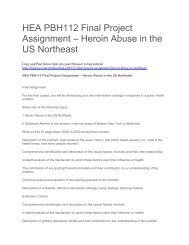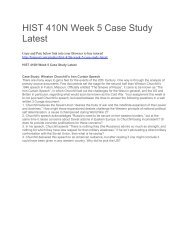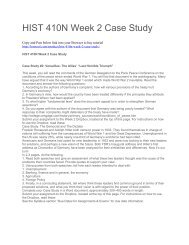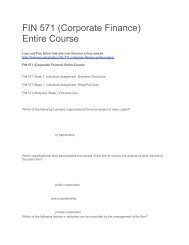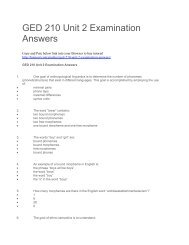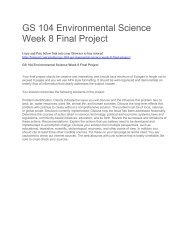FIN 516 (Advanced Managerial Finance) Entire Course
Create successful ePaper yourself
Turn your PDF publications into a flip-book with our unique Google optimized e-Paper software.
<strong>FIN</strong> <strong>516</strong> Week 4 Homework<br />
Problem 23-3 on Implied Price of Funding Based on Chapter 23<br />
Starware Software was founded last year to develop software for gaming applications. Initially, the<br />
founder invested $800,000 and received 8 million shares of stock. Starware now needs to raise a second<br />
round of capital, and it has identified an interested venture capitalist. This venture capitalist will invest $1<br />
million and wants to own 20% of the company after the investment is completed.<br />
a) How many shares must the venture capitalist receive to end up with 20% of the company? What is the<br />
implied price per share of this funding round?<br />
b) What will the value of the whole firm be after this investment (the post-money valuation)?<br />
Problem 23-4 on IRR of Venture Capital Based on Chapter 23<br />
(Excel file included)<br />
Suppose venture capital firm GSB partners raised $100 million of committed capital. Each year over the<br />
10-year life of the fund, 2% of this committed capital will be used to pay GSB’s management fee.<br />
As is typical in the venture capital industry, GSB will only invest $80 million (committed capital less<br />
lifetime management fees). At the end of 10 years, the investments made by the fund are worth $400<br />
million. GSB also charges 20% carried interest on the profits of the fund (net of management fees).<br />
a) Assuming the $80 million in invested capital is invested immediately and all proceeds were received at<br />
the end of 10 years, what is the IRR of the investments GSB partners made? That is, compute IRR<br />
ignoring all management fees.<br />
b) Of course, as an investor or limited partner, you are more interested in your own IRR (that is, the IRR<br />
including all fees paid). Assuming that investors gave GSB partners the full $100 million up front, what is<br />
the IRR for GSB’s limited partners (that is, the IRR net of all fees paid)?<br />
Problem 23-13 on IPO Based on Chapter 23<br />
Your firm has 10 million shares outstanding, and you are about to issue 5 million new shares in an IPO.<br />
The IPO price has been set at $20 per share, and the underwriting spread is 7%. The IPO is a big<br />
success with investors, and the share price rises to $50 on the first day of trading.<br />
a) How much did your firm raise from the IPO?<br />
b) What is the market value of the firm after the IPO?<br />
c) Assume that the post-IPO value of your firm is its fair market value. Suppose your firm could have<br />
issued shares directly to investors at their fair market values in a perfect market with no underwriting<br />
spread and no underpricing. What would the share price have been in this case, if you raise the same<br />
amount as in part a)?<br />
d) Comparing part b) and part c), what is the total cost to the firm’s original investors due to market<br />
imperfections from the IPO?<br />
<strong>FIN</strong> <strong>516</strong> Week 5 IPO Paper<br />
IPO Analysis of Gevo Inc.<br />
<strong>Advanced</strong> <strong>Managerial</strong> <strong>Finance</strong><br />
<strong>FIN</strong> <strong>516</strong> Week 5 Homework<br />
Problem 25-6 on Purchase Versus Lease Based on Chapter 25<br />
Craxton Engineering will either purchase or lease a new $756,000 fabricator. If purchased, the fabricator<br />
will be depreciated on a straight-line basis over 7 years. Craxton can lease the fabricator for $130,000 per<br />
year for 7 years. Craxton’s tax rate is 35%. (Assume the fabricator has no residual value at the end of the<br />
7 years.)<br />
a) What are the free cash flow consequences of buying the fabricator if the lease is a true tax lease?<br />
b) What are the free cash flow consequences of leasing the fabricator if the lease is a true tax lease?<br />
c) What are the incremental free cash flows of leasing versus buying?<br />
Problem 25-7 on Purchase Versus Lease Based on Chapter 25<br />
Riverton Mining plans to purchase or lease $220,000 worth of excavation equipment. If purchased, the



